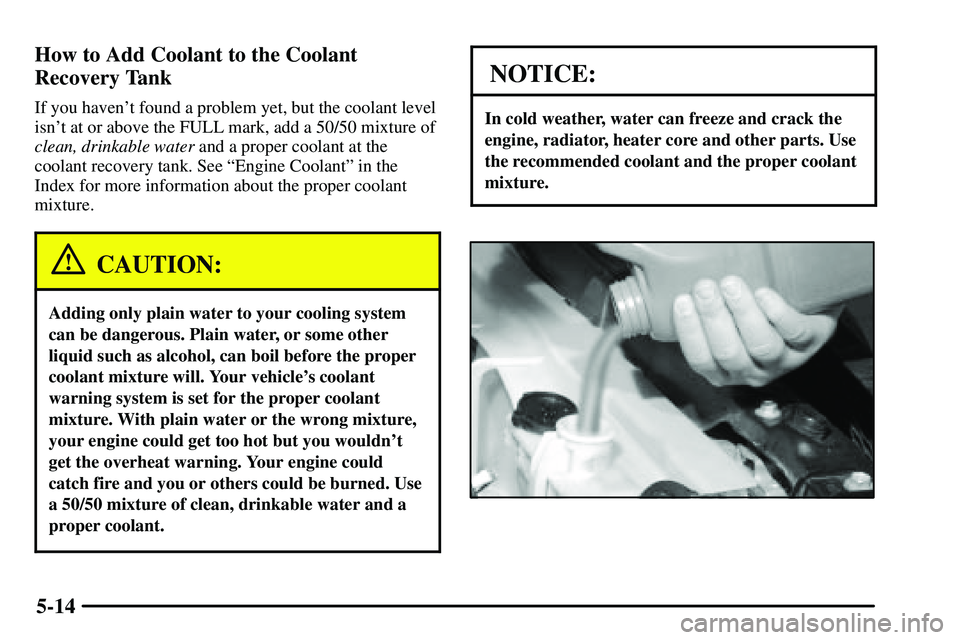Page 225 of 381

5-14 How to Add Coolant to the Coolant
Recovery Tank
If you haven't found a problem yet, but the coolant level
isn't at or above the FULL mark, add a 50/50 mixture of
clean, drinkable water and a proper coolant at the
coolant recovery tank. See ªEngine Coolantº in the
Index for more information about the proper coolant
mixture.
CAUTION:
Adding only plain water to your cooling system
can be dangerous. Plain water, or some other
liquid such as alcohol, can boil before the proper
coolant mixture will. Your vehicle's coolant
warning system is set for the proper coolant
mixture. With plain water or the wrong mixture,
your engine could get too hot but you wouldn't
get the overheat warning. Your engine could
catch fire and you or others could be burned. Use
a 50/50 mixture of clean, drinkable water and a
proper coolant.
NOTICE:
In cold weather, water can freeze and crack the
engine, radiator, heater core and other parts. Use
the recommended coolant and the proper coolant
mixture.
Page 277 of 381

6-32 What to Use
Use a mixture of one-half clean, drinkable water and
one
-half coolant that meets GM Specification 1825-M,
which won't damage aluminum parts. You can also use a
recycled coolant conforming to GM Specification 1825
-M
with a complete coolant flush and refill. If you use this
coolant mixture, you don't need to add anything else.
CAUTION:
Adding only plain water to your cooling system
can be dangerous. Plain water, or some other
liquid such as alcohol, can boil before the proper
coolant mixture will. Your vehicle's coolant
warning system is set for the proper coolant
mixture. With plain water or the wrong mixture,
your engine could get too hot but you wouldn't
get the overheat warning. Your engine could
catch fire and you or others could be burned. Use
a 50/50 mixture of clean, drinkable water and the
proper coolant.
NOTICE:
If you use an improper coolant mixture, your
engine could overheat and be badly damaged.
The repair cost wouldn't be covered by your
warranty. Too much water in the mixture can
freeze and crack the engine, radiator, heater core
and other parts.
If you have to add coolant more than four times a year,
have your dealer check your cooling system.
NOTICE:
If you use the proper coolant, you don't have to
add extra inhibitors or additives which claim to
improve the system. These can be harmful.
Page 321 of 381

6-76
Replacement Bulbs
Lamps Bulb Number
Headlamp High
-/Low-Beam 9003. . . . . . . . . . . . . . .
Front Turn Signal 1157NA. . . . . . . . . . . . . . . . . . . . . .
Stoplamps/Taillamps 7443. . . . . . . . . . . . . . . . . . . . .
Back
-Up Lamps 7440. . . . . . . . . . . . . . . . . . . . . . . . .
Rear Turn Signal 7440. . . . . . . . . . . . . . . . . . . . . . . .
CHMSL 921. . . . . . . . . . . . . . . . . . . . . . . . . . . . . . . .
Capacities and Specifications
The following approximate capacities are given in
English and metric conversions.
Cooling System
1.8L Engine (Code 8) 6.9 quarts (6.5 L). . . . . . . . .
1.8L H.O. Engine (Code L) 7.1 quarts (6.7 L). . . . Engine Oil with Filter
1.8L Engine (Code 8) 3.9 quarts (3.7 L). . . . . . . . .
1.8L Engine (Code L) 4.8 quarts (4.4 L). . . . . . . . .
Fuel Tank
With AWD 12.0 gallons (45.0 L). . . . . . . . . . . . . . . .
Without AWD 13.0 gallons (49.0 L). . . . . . . . . . . . .
Automatic Transaxle
1.8L Engine (Code 8) 3.3 quarts (3.1 L). . . . . . . . .
1.8L Engine (Code 8)
with AWD 3.1 quarts (2.9 L). . . . . . . . . . . . . . . . . .
Manual Transaxle
Five-Speed 2.0 quarts (1.9 L). . . . . . . . . . . . . . . . .
Six
-Speed 2.4 quarts (2.3 L). . . . . . . . . . . . . . . . . .
Rear Differential0.5 quarts (0.5 L) . . . . . . . . . . . . .
Transfer Case0.8 quarts (0.8 L) . . . . . . . . . . . . . . . .
All capacities are approximate. When adding, be sure to
fill to the approximate level, as recommended in this
manual. See ªRecommended Fluids and Lubricantsº
in the Index.